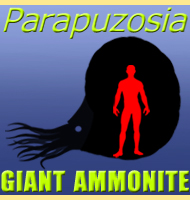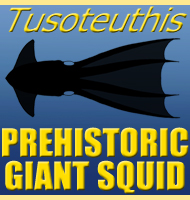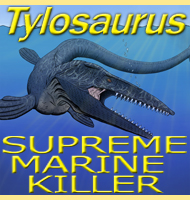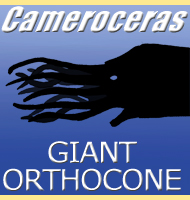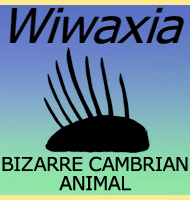


Diplomoceras
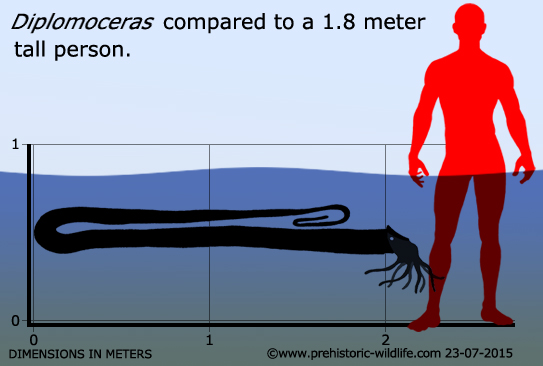
Name:
Diplomoceras
(double horn).
Phonetic: Dip-lo-mo-seh-rass.
Named By: Hyatt - 1900.
Synonyms: Eudiplomoceras.
Classification: Animalia, Mollusca, Cephalopoda.
Species: D. cylindraceum, D. lambi,
D. notabile.
Diet: Carnivore/Piscivore.
Size: Large individuals had shells up to 2
meters across (4 meters or more when you account for the shell
winding).
Known locations: Worldwide distribution with fossil
site locations including Antarctica - Lopez de Bertodano
Formation, Santa Marta Formation. Australia - Korojon
Calcarenite Formation, Miria Formatio. Belgium - Craie de Ciply
Formation, Maastricht Formation. Chile - Quiriquina Formation,
Rio Blanco Formation, Santa Ana Formation. Denmark - Danish
White Chalk Formation. France - Craie de Valognes Formation,
Les Vignes Formation. Greenland. Japan - Senpohshi Formation.
Netherlands - Maastricht Formation. Russia. South Africa.
Spain - Vallcarga Formation. Tunisia. USA, Alabama -
Prairie Bluff Formation;, Alaska - Kaguyak Formation,
Matanuska Formation; California - Moreno Formation;
Mississippi - Prairie Bluff Formation; Texas - Corsicana
Marl Formation, Escondido Formation.
Time period: Campanian to Maastrichtian of the
Cretaceous.
Fossil representation: Well over a hundred specimens
known from shells with varying degrees of preservation.
While
most ammonites had shells that wound tightly in a spiral,
Diplomoceras was more unusual. The shells starts
out straight before
making a U-bend, then growing out back the other way before making
another U-bend around. The shell then continues growing again until
making yet another U-bend and turning back on itself, extending all
the way back beyond the extent of the shell before the head opening
appears.
The
exact reason why Diplomoceras grew such an unusual
shell is unknown.
One reason could be so that species of Diplomoceras
could recognise
one another apart from the other species of ammonites that were
swimming in the oceans at this time. A more streamlined shell may
have also allowed for faster swimming similar to that of earlier
orthocones, and may have allowed for a greater chance of predator
evasion from the large shell crushing mosasaurs
such as Proganthodon
and Globidens
that were common in the Late Cretaceous seas. This
might also explain why Diplomoceras did not appear
until the Campanian
period of the late Cretaceous.
Whatever
the reason why Diplomoceras grew such an unusual
shell, the genus was
clearly very successful. So far fossils of Diplomoceras
have been
found very common in Antarctica and Australia, but are also known
from the Americas, Europe, Africa and also Japan, which combined
with the Australian and Antarctic fossils suggest that Diplomoceras
were common across most of the world’s oceans, until finally
vanishing in the KT extinction at the end of the Cretaceous.
Further reading
- The Upper Cretaceous cephalopod fauna of Graham Land. -
Falkland Islands Dependencies Survey Scientific Reports 3:1-60. -
L. F. Spath - 1953.
- Late Cretaceous ammonites from Seno Skyring-Strait of Magellan
area, Magallanes Province, Chile. Journal of Paleontology
46(4):520-532. - A. Lahsen & R. Charrier -
1972.
- Late Campanian-Maastrichtian ammonite fauna from Seymour Island
(Antarctic Peninsula). The Paleontological Society Memoir
18:1-59. - C. E. Macellari - 1986.
- Maastrichtian heteromorph ammonites from the Carnarvon Basin,
Western Australia. - Alcheringa 16:133-170. - R. A.
Henderson, W. J. Kennedy & K. J. McNamara -
1992.
- Discovery of a remarkably complete specimen of the giant cephalopod
Diplomoceras maximum from the Late Cretaceous of
Seymour Island,
Antarctica. - Antarctic Journal of the United States, Vol. 30
Issue 5, p9. - William J. Zinsmeister & Anton E.
Oleinik - 1995.
- Observations on the systematics, geographic and stratigraphic
distribution and origin of Diplomoceras cylindraceum
(Defrance,
1816). - Annals of The South African Museum 110: 171-198.
- Herbert Christian Klinger & William James Kennedy -
2003.
----------------------------------------------------------------------------
Random favourites
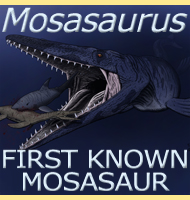 |
 |
 |
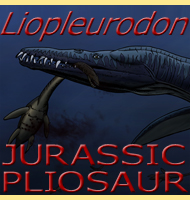 |
